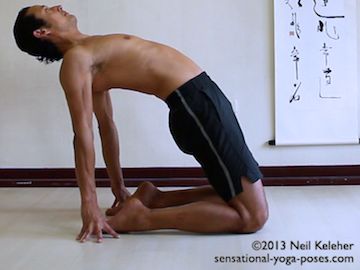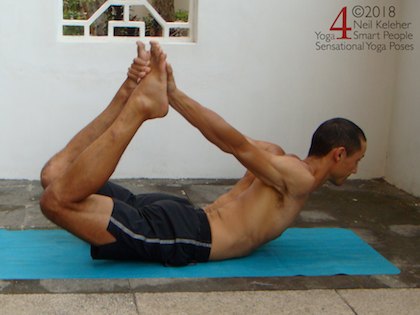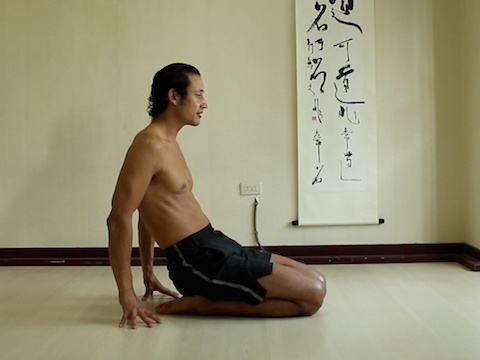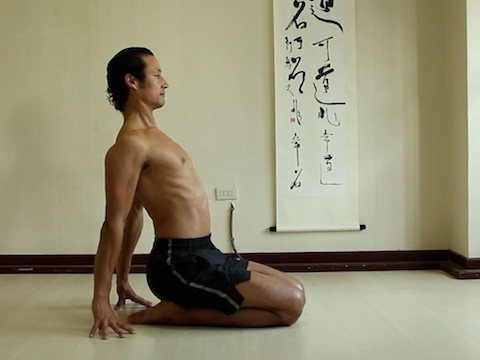Camel Yoga Pose
On page cat links

Camel yoga pose (ustrasana) is both a hip flexor stretch and a back bend. It can be used to stretch the fronts of the shoulders, and depending on how you do it, the fronts of the arms.
On page cat links

Camel yoga pose (ustrasana) is both a hip flexor stretch and a back bend. It can be used to stretch the fronts of the shoulders, and depending on how you do it, the fronts of the arms.
I think that the usual entry into camel yoga pose is to stand on the knees and then reach the hands back and down.
Personally I like to start with my butt on my heels and my hands on the floor behind me. Then I push up into the pose.
But to start, before lifting up, I like to move the shoulders back to retract the shoulder blades. (Actually, if you have scapular awareness, then retract the shoulder blades to move the shoulders back.)
Then I like to bend the thoracic spine (and lumbar spine) backwards so that the front of the ribcage is opened.
The pelvis may have to tilt forwards to help the lumbar spine bend backwards.
Then from there, keeping those actions activated, then I push the pelvis forwards and up.
One action that I just discovered for myself is to focus on pulling the knees back.

In bow pose (above), you pull the knees up relative to the pelvis so that you open or stretch the front of the hip joint. And you use the arms to help. The feeling is similiar in camel yoga pose but perhaps not so obvious since in camel yoga pose the knees are on the floor.

Just my fingers tips are on the floor in this picture. You could also do camel pose with the palms flat on the floor.
In camel yoga pose (above) the knees are on the floor but the pelvis isn't. So you may find that pulling the knees back helps to push the pelvis forwards.
(And actually, since the knees don't move, focus on creating the feeling of pulling the knees back... pull them back relative to the pelvis.)
You may find that you get a feeling of contraction (or muscle activation) in both the back of the thigh and the front.
Other actions that you can play around with separately are trying to pull the feet up (as if trying to lift them off of the floor.) Then try pushing the feet and toes down, into the floor.
Each action affects the pose differently, and depending on what you have done prior to camel pose and what you plan on doing afterwards, one or the other action may be more desirable or more effective.
At the point of writing I haven't experimented with combining the knee action with either of the foot actions. I'd suggest that pulling the knees back would go better with pushing the feet down. However, when doing it you may have to vary or adjust the pressure with which you press the feet down compared to the force you use to pull the knees back.
Feel these actions and balance them, finding the amount of exertion in each actin so that the two actions work well together.
While kneeling, place your hands on the floor behind you. First practice lifting your chest and lowering it. As you lift your chest push your hands forwards against the floor.
Do this slowly and see if you can notice the top side of your shoulders feeling like they are being pulled back.


Once comfortable with this action, lift your hips. Keep them lifted and as you inhale push them forwards. As you exhale relax a little. Repeat this a few times, pushing your hips forwards each time you inhale.

One of the main hip flexor muscles that camel yoga pose can be used to stretch is the psoas. You are actually stretching it in two ways in camel pose, one by bending the spine backwards, secondly by pushing the pelvis forwards at the same time.
Because the psoas is being pulled from two different directions at the same time it may contract, making it difficult to stretch.
To alleviate this problem try pressing the tops of you inner thighs forwards as you press your pelvis forwards. The idea of this action is to bring the insertion point of the psoas on the inner thigh closer to the front of the pelvis. So as you push your pelvis forwards, you let the "thigh attached" end of the psoas move closer to it's attachment to the lumbar spine. The psoas may then relax enough for you to lengthen it by bending your lumbar spine backwards as you push your pelvis forwards.
As you push your pelvis forwards, focus on pushing the top of your inner thighs forwards at the same time. It'll feel like the meat at the top of your inner thighs is pushing forwards from between your legs.
The arm action is also important in camel yoga pose.
If you just keep your arms relaxed, you may find that you can't push your pelvis as far forwards. Pushing the hands forwards either against the feet or against the floor changes the tension within the body and somehow makes it easier for the pelvis to press forwards.
Rather than trying to explain it I suggest trying to feel it for yourself.
If you start with your hands on your feet you may find it easier to press your pelvis far enough forwards that your thighs become vertical. Then experiment with doing ustrasana with your hands on the floor (or your finger tips on the floor.)
One other adjustment that may also help your psoas to relax is to slowly tip your head backwards and then to slowly relax your neck. By relaxing the muscles of the front of the neck you may help induce the psoas to relax since the two sets of muscles are synertists, they tend to work together (and relax together.)
After this hip flexor and psoas stretch, you can rest with your chest on your knees and your hands back, in childs pose.
